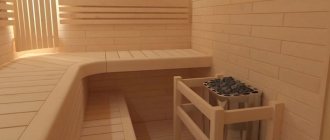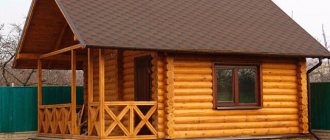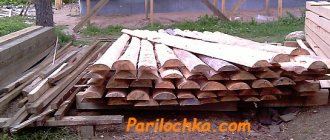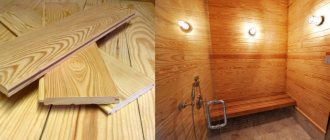The unique atmosphere of pampering and health that reigns in the bathhouse does not leave a single person indifferent. And covering this room with high-quality material is one of the important points in construction.
Most often, baths are lined with wooden clapboard. When choosing lining for finishing a steam room in a bathhouse, take into account all the properties of the wood from which the material is made.
One of the most used types of wood for finishing the steam room of a bathhouse is lining made of linden wood. Let's figure out why. What are the pros and cons of this material?
Linden. Why is it called the “bath tree”?
Perhaps the most important property of linden for us in the construction of baths is the porosity and lightness of this tree. After all, it is quite obvious to anyone more or less familiar with the basics of thermal conductivity that linden conducts heat much weaker than trees with dense and heavy wood, such as oak or beech. Having made a shelf from linden, you will never be able to get burned on it, even in a very hot bath. This shelf is “soft”, “affectionate” in feel, pleasant to the touch and easy to process. As for the walls, a steam room decorated with a linden slab is essentially a “thermos” - linden walls do not absorb heat and do not release it outside, thereby reducing heat loss. But that's not all. The most important advantage of the linden tree, which makes it a bath tree, is the ability of the linden croaker to exude the most delicate honey aroma. And this feature of linden wood is preserved throughout its service for the benefit of humans. Conduct an experiment... Warm up the linden steam room to working condition and ask someone to pour plain water on the hot walls. Now enter the steam room and take a deep breath through your nose. You will feel an incredible honey spirit, a subtle aroma of something native, recorded at the genetic level. This is what a bathhouse with linden slab trim smells like. No other tree gives such an effect.
Characteristics of building materials
The pros and cons of a linden bath are determined, of course, by the operational and technical characteristics of the material used in construction.
Advantages
- As a cladding, linden is good because it does not emit resin at all, so you don’t have to worry about the presence of various impurities in the hot air of the steam room. This determines the high safety of using linden for interior cladding of bathhouses.
- Linden wood can breathe, which has a positive effect on the entire structure as a whole. Indeed, in this case, the building material retains its natural qualities for quite a long time. This means that linden can be used not only for interior decoration, but also for the construction of various elements of a bath interior, as well as as a building material for the construction of walls and roofs.
- The fact that linden wood is excellent for constructing a bathhouse is evidenced by its pliability to various types of processing. Consequently, all preparatory manipulations, along with subsequent installation, can easily be done with your own hands.
- Linden in a bathhouse, when heated, can fill the atmosphere of a steam room with an amazing smell. Moreover, hot air does not deprive linden wood of its healing and performance qualities.
Flaws
However, linden also has disadvantages.
- The most important thing is that it is not durable. In order to extend the service life of this building material, the interior of the bathhouse must be ventilated after each use of the steam room. This will make it possible to avoid the rapid occurrence of rotting processes.
- By the way, it will be said that linden begins to rot from the inside, which quite often does not allow us to detect the problem in time and promptly replace the element that has begun to deteriorate.
- Separately, it is necessary to say about the cost of linden wood. This indicator depends on the method of procurement of building materials. If drying was carried out artificially, the price of linden products will be slightly higher than in the case of a natural occurrence of this process.
Preparation of linden croaker
Harvesting lime croaker is not an easy task. It would seem that it would be easier, cut the linden trunk into boards and finish the steam room as you want, but don’t rush - it’s not that simple. Linden is a special tree; it shrinks greatly when dried and has another feature - a predisposition to infection with blue mold. This fungal disease covers the board completely, growing inside and making it completely unsuitable for bathhouse construction. Therefore, you even need to be able to store linden, not to mention working with this tree. By the way, you noticed that on the linden slab installed in the bathhouse, there are places that seem poorly treated from the bark. So this is bast. Bast has protective and aesthetic functions in the bathhouse. A linden tree without a bast looks rather dull and monotonous. Therefore it is important! be able to remove the bark so that the bast remains on the log. It is worth noting that this is done only manually, with special tools, which somewhat justifies the rather high price of linden croaker. In order for the bast to hold up well, it is necessary to harvest only winter wood , since nature itself ensures that the tree is preserved and the sap flow in it is suspended. The high cost of the linden croaker is also facilitated by the small habitat of the linden - this tree has become a biosphere rarity in some regions. Appreciate the linden tree! Take care of her!
A little about construction
timber
Linden timber is an excellent material for building a bathhouse.
Advice! When choosing linden timber for building a bathhouse, you must carefully ensure that the surface of these elements is clean. That is, the presence of cracks, chips and other unwanted inclusions should be completely excluded. In addition, the color of the product should be evenly distributed over its entire surface.
Before installing the timber, the foundation must be insulated, and special slats must be laid on top of the thermal insulation, which will prevent the beams from touching the base, and will also ensure ventilation of the building material.
Next, the beam itself is mounted on the mentioned slats. The first crown must be carefully checked for the evenness of all planes.
As for fixing this row, this manipulation is not required for two reasons:
- The weight of the structure will reliably fix the lower crown without corresponding elements.
- If such a need arises, loose beams will be easier to remove.
The lower crown of the beam does not require additional fixation.
After the lower beams are in place and are perfectly aligned using special tools, you can begin laying the second row. Here you can no longer do without fastening elements, which are metal pins or wooden dowels.
To carry out the installation operation, holes are made at the ends of each beam through which the building material is placed on the fasteners. It is important that these perforations exactly match the size of the pins.
It is necessary to lay a heat-insulating layer between the crowns in order to additionally protect the structure from the influence of various negative factors related to the environment.
A linden bathhouse has one feature that distinguishes it qualitatively from its sisters, built using other types of wood. We are talking about two upper crowns, which are usually not fixed until the structure shrinks.
The upper rims are fixed after the structure shrinks.
This is due to the fact that the upper beams, after the bathhouse shrinks, must be dismantled in order to lay the ceilings. In the case of linden, everything is different, since a linden structure is not subject to such a phenomenon as shrinkage. It is for this reason that the upper crowns are fixed immediately, after which the roof is installed.
Lining
Before installing the lining, you need to build a frame. To do this, guide bars are nailed to the wall, between which additional slats are attached.
Then thermal and waterproofing is laid. Lining is sewn on top of these elements (photo).
The lining is fixed on the sheathing, which serves as a frame for thermal insulation.
Advice! The direction of fastening the cladding should be foreseen in advance, since the method of installation of the guide bars, which are always installed perpendicular to the lining boards, depends on this.
Linden steam room - highly valued among bath masters
Experienced bathhouse attendants know for sure that only a linden bathhouse can work for a long time and is easy. Linden honey aroma - makes breathing easier in the steam room. This is due to the fact that linden is an excellent humidity regulator . As soon as you turn on the heater, the lime croaker will immediately absorb excess steam and within two minutes completely balance the ratio of humidity and temperature. Since ancient times, this tree was revered by the Slavs as the “tree of health and happiness.” And in the linden bathhouse you can feel especially clearly how the linden tree takes away negativity and relieves depression. But this is not all fake “miracles”. Only in a linden bathhouse can a person be easily freed from negativity, but also quickly and easily filled with vitality, calmness and tranquility. Linden is a very “durable” tree in the sense that it remains “alive” even after 10 years . To make it clear to you, let’s say for comparison that aspen “lives” after being cut down for only 3 years. Throughout this life, the linden tree continues to carry a unique honey smell and bestows positive energy.
Finishing the steam room with a lime slab is the right decision!
1. The question of the “correctness” of the bath is being resolved. Since the linden tree will take on part of the tasks of regulating the atmosphere of the steam room. 2. With the help of a linden croaker, an amazing aesthetics of the steam room is created . The bast on the slab, the hanging threads of tow, the very shape of the slab - create the image of a log bathhouse and the “wild” pristine nature of the building, as well as the beauty of nature in the color scheme. With each soar, the appearance of the linden tree only becomes more noble and smoother. Ultimately, the linden finish takes on an antique value in its external characteristics. 3. Linden croaker does not require any further processing to maintain its appearance. This is an investment for many years to come with a guaranteed good result.
Why choose linden
It’s hard to argue with its environmental friendliness.
Let’s list all the properties for which linden is loved by both masters and beginners who decided to build a bathhouse with their own hands:
- Linden wood has a low density - 490-530 kg/m³ (pine 470 kg/m³), which means that after getting wet it dries quickly;
- Linden has virtually no resinous substances, which cause a lot of trouble when heated. But its essential oils, at high temperatures, create a unique aroma in the steam room, which has an excellent therapeutic effect for healing the body;
- The color of linden wood depends on many factors, but it is always warm and light tones. You can choose almost white wood, pastel yellow or pink. Less common, but found, are light brown shades;
- Linden wood withstands changes in humidity without deformation or cracking.
Check purchased materials for compliance with GOST 8242-88
How wood becomes clapboard
Linden is grown on an industrial scale specifically for the production of building materials. This process is not quick - the tree must be at least 60 years old. Logs, or it is correct to say round timber, are sawn into boards.
Raw materials for the production of lining
- They are dried in special chambers for a certain time;
- During this process, many boards are rejected, and the finished raw material is subjected to further processing on special machines - a groove and ridge are formed that connect the boards to each other;
- Finally, each plank is processed and polished. The cost of the finished product is determined by this lengthy process.
Preliminary natural drying
Classification of lining by grade
Regardless of what type of wood the board is made from, the grade standards are the same for all:
- The highest grade is “Extra”. This type of lining is made from the middle part of the tree, which does not contain knots, cracks or any other defects. Has a uniform shade and smooth texture;
- Grade “A” is also of high quality, but the presence of one knot per 1.5 m is already acceptable;
- Grade “B” is allowed the presence of 4 knots per 1.5 m, small cracks and deformations;
- Grade “C” is the lowest in this category and is not suitable for baths. Such a board will become unusable very quickly due to an environment unfavorable for wood.
A clear example
There is also a separate class of lining - eurolining. Such panels are manufactured according to European standards (DIN) and have a design difference - deeper grooves and, accordingly, longer scallops, as well as additional channels for ventilation and water drainage. The price of eurolining is significantly higher than the cost of “Extra” class panels.
Classification according to DIN 68126/86
In addition, there are differences in the profile. The photo shows their main types:
Types of imported lining presented on the building materials market
Components of a good bath
To obtain good steam, which in the old days was also called “soluble air,” several components are important to us. First on this list is a convenient and fast stove-heater . Whatever one may say, this is the heart of the bathhouse, and you will have to “dance” from the stove in any case. Of course, you will make a decision on your own, but why not rely on the vast experience of those who have been operating private baths and bath clubs for many years? We recommend paying attention to the ParAvoz stove , it is also called the Steam Locomotive sauna stove or Dobrovolsky stove. The second component of a good bath is linden . It is the linden croaker that makes the bathhouse unique. It's like fingerprints - no two steam rooms are the same, even if they are made according to the same project. You read about other advantages above. The main thing in the bathhouse rightfully remains - Man . And everything here is done for his benefit and pleasure. Go for it!
Installation of lining
You can cover the premises of your future bathhouse with linden clapboards yourself. As mentioned above, such wood is easy to work with.
Simple instructions and simple rules will help you avoid mistakes:
- Installation is best done in the warm season or in a well-heated room;
- The lining (any) should lie in a warm place for several days;
- The lathing under the lining is attached horizontally, in increments of 40-50 cm;
We set the sheathing according to the level
- It is advisable to use insulation with an aluminum reflector;
- For baths, according to GOST, a board with a thickness of 12-25 mm is used;
- The lining is placed vertically or diagonally (so that water that gets on the walls does not linger in the grooves, but flows down freely);
The panels should be fixed vertically using clamps
- All surfaces should be treated with an antiseptic. The service life of your coating depends on the quality of processing;
- After the bactericidal solution has dried, cover the wood with protective gels, glaze or special bath varnish (regular wood varnishes cannot be used here!)
Use only special environmentally friendly varnishes
A little advice: for small rooms it is better to use lining 70-90 cm wide. This will create the illusion of a large space. A wider plank size will visually “swallow” both the height and volume of the room.
Perhaps this video will help beginners avoid mistakes when building a bathhouse.











